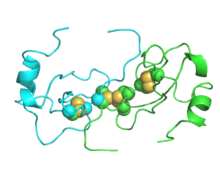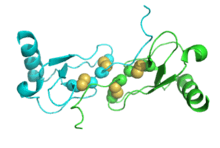Macrophage inflammatory protein
| chemokine (C-C motif) ligand 3 | |
|---|---|
 | |
| Identifiers | |
| Symbol | CCL3 |
| Alt. symbols | SCYA3, MIP-1α |
| Entrez | 6348 |
| HUGO | 10627 |
| OMIM | 182283 |
| PDB | 1B50 More structures |
| RefSeq | NM_002983 |
| UniProt | P10147 |
| Other data | |
| Locus | Chr. 17 q12 |
| chemokine (C-C motif) ligand 4 | |
|---|---|
 | |
| Identifiers | |
| Symbol | CCL4 |
| Alt. symbols | SCYA4, MIP-1β, LAG1 |
| Entrez | 6351 |
| HUGO | 10630 |
| OMIM | 182284 |
| PDB | 1HUM More structures |
| RefSeq | NM_002984 |
| UniProt | P13236 |
| Other data | |
| Locus | Chr. 17 q21-q23 |
Macrophage Inflammatory Proteins (MIP) belong to the family of chemotactic cytokines known as chemokines. In humans, there are two major forms, MIP-1α and MIP-1β that are now officially named CCL3 and CCL4, respectively. Both are major factors produced by macrophages after they are stimulated with bacterial endotoxins.[3] They are crucial for immune responses towards infection and inflammation.[4] They activate human granulocytes (neutrophils, eosinophils and basophils) which can lead to acute neutrophilic inflammation. They also induce the synthesis and release of other pro-inflammatory cytokines such as interleukin 1 (IL-1), IL-6 and TNF-α from fibroblasts and macrophages. The genes for CCL3 and CCL4 are both located on human chromosome 17.[5]
They are produced by many cells, particularly macrophages, dendritic cells, and lymphocytes.[6] MIP-1 are best known for their chemotactic and proinflammatory effects but can also promote homoeostasis.[6] Biophysical analyses and mathematical modelling has shown that MIP-1 reversibly forms a polydisperse distribution of rod-shaped polymers in solution. Polymerization buries receptor-binding sites of MIP-1, thus depolymerization mutations enhance MIP-1 to arrest monocytes onto activated human endothelium.[4]
See also
References
- ↑ Czaplewski, L. G.; McKeating, J.; Craven, C. J.; Higgins, L. D.; Appay, V.; Brown, A.; Dudgeon, T.; Howard, L. A.; Meyers, T.; Owen, J.; Palan, S. R.; Tan, P.; Wilson, G.; Woods, N. R.; Heyworth, C. M.; Lord, B. I.; Brotherton, D.; Christison, R.; Craig, S.; Cribbes, S.; Edwards, R. M.; Evans, S. J.; Gilbert, R.; Morgan, P.; Randle, E.; Schofield, N.; Varley, P. G.; Fisher, J.; Waltho, J. P.; Hunter, M. G. (1999). "Identification of amino acid residues critical for aggregation of human CC chemokines macrophage inflammatory protein (MIP)-1alpha, MIP-1beta, and RANTES. Characterization of active disaggregated chemokine variants". The Journal of Biological Chemistry. 274 (23): 16077–16084. doi:10.1074/jbc.274.23.16077. PMID 10347159.
- ↑ Lodi, P. J.; Garrett, D. S.; Kuszewski, J.; Tsang, M. L.; Weatherbee, J. A.; Leonard, W. J.; Gronenborn, A. M.; Clore, G. M. (1994). "High-resolution solution structure of the beta chemokine hMIP-1 beta by multidimensional NMR". Science. 263 (5154): 1762–1767. doi:10.1126/science.8134838. PMID 8134838.
- ↑ Sherry B, Tekamp-Olson P, Gallegos C, Bauer D, Davatelis G, Wolpe SD, Masiarz F, Coit D, Cerami A (December 1988). "Resolution of the two components of macrophage inflammatory protein 1, and cloning and characterization of one of those components, macrophage inflammatory protein 1 beta". J. Exp. Med. 168 (6): 2251–9. doi:10.1084/jem.168.6.2251. PMC 2189160
 . PMID 3058856.
. PMID 3058856. - 1 2 Ren M, Guo Q, Guo L, et al. (December 2010). "Polymerization of MIP-1 chemokine (CCL3 and CCL4) and clearance of MIP-1 by insulin-degrading enzyme". EMBO J. 29 (23): 3952–66. doi:10.1038/emboj.2010.256. PMC 3020635
 . PMID 20959807.
. PMID 20959807. - ↑ Irving SG, Zipfel PF, Balke J, McBride OW, Morton CC, Burd PR, Siebenlist U, Kelly K (June 1990). "Two inflammatory mediator cytokine genes are closely linked and variably amplified on chromosome 17q". Nucleic Acids Res. 18 (11): 3261–70. doi:10.1093/nar/18.11.3261. PMC 330932
 . PMID 1972563.
. PMID 1972563. - 1 2 Maurer M, von Stebut E (October 2004). "Macrophage inflammatory protein-1". Int. J. Biochem. Cell Biol. 36 (10): 1882–6. doi:10.1016/j.biocel.2003.10.019. PMID 15203102.
External links
- Macrophage Inflammatory Proteins at the US National Library of Medicine Medical Subject Headings (MeSH)